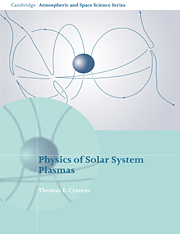Book contents
- Frontmatter
- Contents
- Preface
- Physical constants
- Vector calculus identities
- 1 Space physics
- 2 Introduction to kinetic theory
- 3 Single particle motion and geomagnetically trapped particles
- 4 Magnetohydrodynamics
- 5 Solar physics
- 6 The solar wind
- 7 The solar wind interaction with planets and other solar system bodies
- 8 The magnetosphere
- Appendix
- Index
4 - Magnetohydrodynamics
Published online by Cambridge University Press: 26 October 2009
- Frontmatter
- Contents
- Preface
- Physical constants
- Vector calculus identities
- 1 Space physics
- 2 Introduction to kinetic theory
- 3 Single particle motion and geomagnetically trapped particles
- 4 Magnetohydrodynamics
- 5 Solar physics
- 6 The solar wind
- 7 The solar wind interaction with planets and other solar system bodies
- 8 The magnetosphere
- Appendix
- Index
Summary
In Chapter 3, we studied how single charged particles move in specified electric and magnetic fields, and we then applied our knowledge of single particle motion to the radiation belt and ring current plasma. However, the fields in some situations depend too much on the particle distributions to be readily specified and must be found self-consistently using the charged particle distribution functions. Often, it is not necessary to have complete information about the distribution functions in a system. In fact, it is usually sufficient to know only a few of the velocity moments of the distribution function, as derived in Chapter 2. In Chapter 4, we will adopt the “fluid” picture of a plasma, introduced in Chapter 2, and further refine it to obtain an analytical tool useful for studying space plasma phenomena. This analytical tool is called magnetohydrodynamics (or MHD for short). We cannot adequately cover in one chapter all the material that would be desirable to know about this subject and so the reader is encouraged to consult one or more of the references listed in the bibliography at the end of this chapter.
Two-fluid plasma
Let us consider a plasma consisting of two species: electrons (e) with mass me and a single ion species (i) with mass mi.
- Type
- Chapter
- Information
- Physics of Solar System Plasmas , pp. 90 - 158Publisher: Cambridge University PressPrint publication year: 1997



